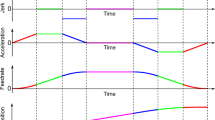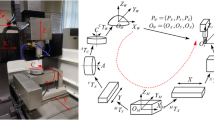Abstract
Five-axis machines with three translational and two rotation axes are becoming increasingly popular in serving the needs of the mass production industry due to their ability to handle geometrically complex workpieces using the rotational axes. Theoretically, the combination of the five axes offers a minimal number of the degrees of freedom required to transport the tool into a prescribed spatial position and establish a required orientation. However, the rotation axes lead to an inevitable nonlinearity of the tool tip trajectory and the so-called kinematics errors appearing due to the specific kinematics of the machine. Eventually, one arrives at an interesting question. Is it possible to compensate this error by introducing an additional rotation axis? In other words, “does an additional rotation axis offer any optimization benefits in the sense of the above mentioned error?” In this paper, we answer this question positively by analyzing a hypothetical six-axis milling machine with two rotation axes on the table and one additional rotation axis on the tool. The sixth axis is build on the top of the existing five-axis machine MAHO600E by Deckel Gildemeister. We present an extension of an optimization algorithm developed earlier by the authors for five-axis machining based on an optimal angle sequencing (the shortest path optimization). The extension is a combination of the shortest path strategy and the use of the additional axis. The algorithm leads to an increase in the machining accuracy, in particular, for rough milling. Numerical experiments and cutting by a virtual six-axis machine built in Vericut 5.0 validates the results of the optimization. The proposed optimization procedure is capable of upgrading the existing five-axis G-codes to the case of six-axis machine.
Similar content being viewed by others
References
Japitana FH, Morishige K, Takeuchi Y (2004) 6-Axis control cutting of overhanging curved grooves by means of non-rotational tool with application of ultrasonic vibrations. Int J Mach Tools Manuf 44:479–486
Takeuchi Y, Yoneyama Y, Ishida T, Kawai T (2009) 6-Axis control ultra precision micro grooving on sculptured surfaces with non-rotational cutting tool. CIRP Annals-Manufacturing Technology 58:53–56
Hsieh J-F, Lin PD (2003) Production of multifluted drills on six-axis CNC tool-grinding machine. Int J Mach Tools Manuf 43:1117–1127
Munlin M, Makhanov SS, Bohez ELJ (2004) Optimization of rotations of a five-axis milling machine near stationary points. Comput-Aided Des 36:1117–1128
Makhanov SS, Munlin M (2005) Optimal sequencing of rotation angles for five-axis machining. Int J Adv Manuf Technol 35:41–54
Makhanov SS, Anotaipaiboon W (2007) Advanced numerical methods to optimize cutting operations of five axis milling machines. Springer, New York
She C-H, Chang C-C (2007) Design of a generic five-axis postprocessor based on generalized kinematics model of machine tool. Int J Mach Tools Manuf 47:537–545
Bohez ELJ (2002) Five-axis milling machine tool kinematics chain design and analysis. Int J Mach Tools Manuf 42:505–520
Omrcen D, Zlajpah L, Nemec B (2007) Compensation of velocity and/or acceleration joint saturation redundant manipulator. Rob Autom Syst 55:337–344
Schmitz TL, Ziegert JC, Canning JS, Zapata R (2008) Case study: A comparison of error sources in high-speed milling. Precis Eng 32:126–133
Honegger CA, Tulsian A, Mukhopadhyay D (2010) Analysis of thermal errors in a high-speed micro-milling spindle. Int J Mach Tools Manuf 50:386–393
Vanherck P, Dehaes J, Nuttin M (1997) Compensation of thermal deformations in machine tools with neural nets. Comput Ind 33:119–125
Donmez M, Hahn M, Soons J (2007) A novel cooling system to reduce thermally-induced errors of machine tools. CIRP Ann 56(1):521–524
Haitao Z, Jianguo Y, Jinhua S (2007) Simulation of thermal behavior of a CNC machine tool spindle. Int J Mach Tools Manuf 47:1003–1010
Ramesh R, Mannan MA, Poo AN (2003) Thermal error measurement and modeling in machine tools. Part I. Influence of varying operating conditions. Int J Mach Tools Manuf 43(4):391–404
Ramesh R, Mannan MA, Poo AN, Keerthi SS (2003) Thermal error measurement and modeling in machine tools. Part II. Hybrid Bayesian Network-support vector machine model. Int J Mach Tools Manuf 3(4):405–419
Meng Lim EE, Meng C-H (1995) The prediction of dimensional error for sculptured surface productions using the ball-end milling process. Part 2. Surface generation model and experimental verification. Int J Mach Tools Manuf 35(8):1171–1185
Matsubara T, Tanaka H, Mizumoto H (1991) Study on accuracy in end milling operations. Int J Jpn Soc Precis Eng 25(4):291–296
Iwabe H, Fujii Y, Saito K, Kishinami T (1994) Study on corner cut by end mill. Int J Jpn Soc Precis Eng 28(8):218–223
Law KMY (1998) Process design for error compensation in end milling of pockets. M. Phil. Thesis, City University of Hong Kong
Law KMY, Geddam A, Ostafiev VA (1999) A process-design approach to error compensation in the end milling of pockets. J Mater Process Tech 89–90:238–244
Law KMY, Geddam A (2003) Error compensation in the end milling of pockets: a methodology. J Mater Process Technol 139:21–27
Weck M, Bibring H (1984) Metrological analysis and performance tests: handbook of machine tools, vol 4. Wiley, Chichester
Bohez ELJ, Ariyajunya B, Sinlapeecheewa C, Shein TMM, Lapd DT, Belforte G (2007) Systematic geometric rigid body error identification of 5-axis milling machines. Comput-Aided Des 39:229–244
Farouki RT, Sakkalis T, Vaserstein L (2009) Non-existence of rational arc-length parametrizations for curves in Rn. J Comput Appl Math 228(1):494–497
Makhanov SS (2010) Adaptable geometric patterns for five-axis machining: a survey. Int J Adv Manuf Technol 47(9–12):1167–1208
Vericut® V5.4 User Manual, URL: http://www.cgtech.com
Author information
Authors and Affiliations
Corresponding author
Rights and permissions
About this article
Cite this article
Mudcharoen, A., Makhanov, S.S. Optimization of rotations for six-axis machining. Int J Adv Manuf Technol 53, 435–451 (2011). https://doi.org/10.1007/s00170-010-2864-3
Received:
Accepted:
Published:
Issue Date:
DOI: https://doi.org/10.1007/s00170-010-2864-3




